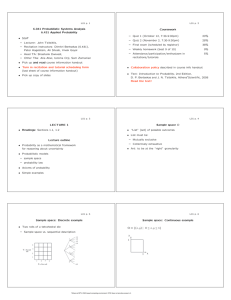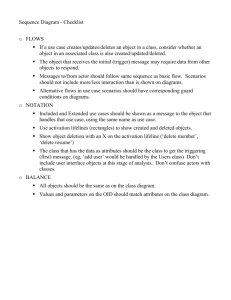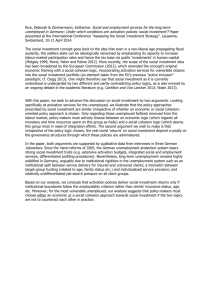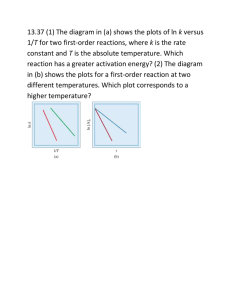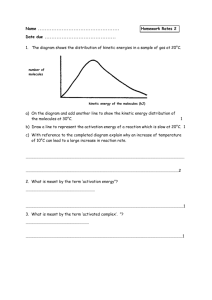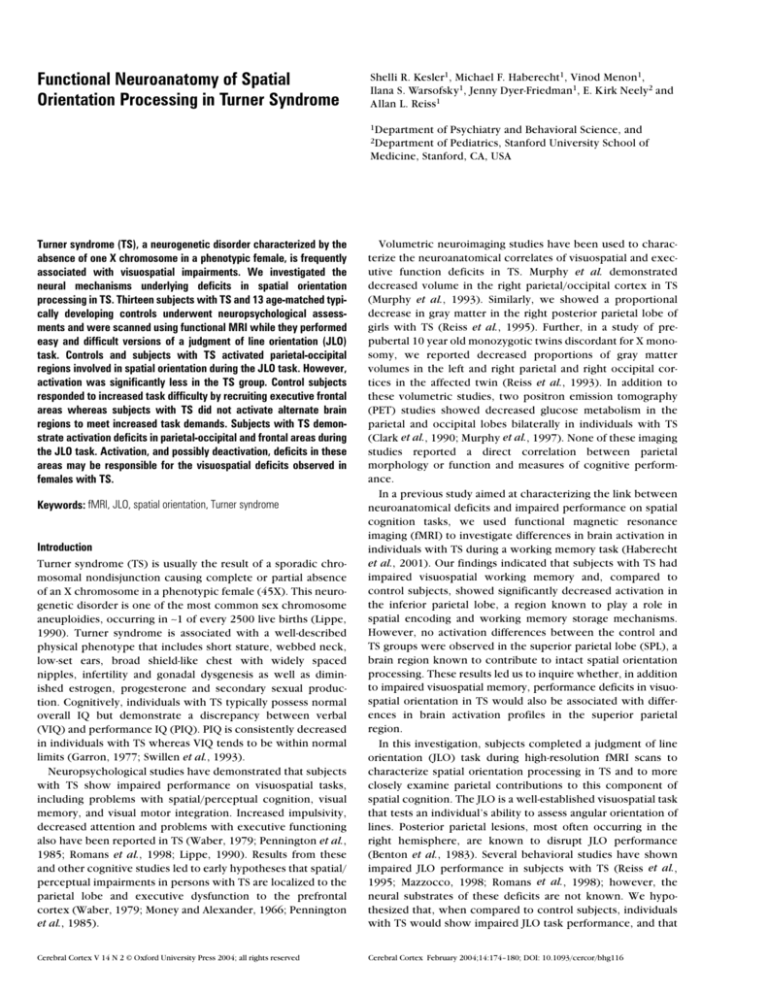
Functional Neuroanatomy of Spatial
Orientation Processing in Turner Syndrome
Shelli R. Kesler1, Michael F. Haberecht1, Vinod Menon1,
Ilana S. Warsofsky1, Jenny Dyer-Friedman1, E. Kirk Neely2 and
Allan L. Reiss1
1Department
of Psychiatry and Behavioral Science, and
of Pediatrics, Stanford University School of
Medicine, Stanford, CA, USA
2Department
Turner syndrome (TS), a neurogenetic disorder characterized by the
absence of one X chromosome in a phenotypic female, is frequently
associated with visuospatial impairments. We investigated the
neural mechanisms underlying deficits in spatial orientation
processing in TS. Thirteen subjects with TS and 13 age-matched typically developing controls underwent neuropsychological assessments and were scanned using functional MRI while they performed
easy and difficult versions of a judgment of line orientation (JLO)
task. Controls and subjects with TS activated parietal-occipital
regions involved in spatial orientation during the JLO task. However,
activation was significantly less in the TS group. Control subjects
responded to increased task difficulty by recruiting executive frontal
areas whereas subjects with TS did not activate alternate brain
regions to meet increased task demands. Subjects with TS demonstrate activation deficits in parietal-occipital and frontal areas during
the JLO task. Activation, and possibly deactivation, deficits in these
areas may be responsible for the visuospatial deficits observed in
females with TS.
Turner syndrome (TS) is usually the result of a sporadic chromosomal nondisjunction causing complete or partial absence
of an X chromosome in a phenotypic female (45X). This neurogenetic disorder is one of the most common sex chromosome
aneuploidies, occurring in ∼1 of every 2500 live births (Lippe,
1990). Turner syndrome is associated with a well-described
physical phenotype that includes short stature, webbed neck,
low-set ears, broad shield-like chest with widely spaced
nipples, infertility and gonadal dysgenesis as well as diminished estrogen, progesterone and secondary sexual production. Cognitively, individuals with TS typically possess normal
overall IQ but demonstrate a discrepancy between verbal
(VIQ) and performance IQ (PIQ). PIQ is consistently decreased
in individuals with TS whereas VIQ tends to be within normal
limits (Garron, 1977; Swillen et al., 1993).
Neuropsychological studies have demonstrated that subjects
with TS show impaired performance on visuospatial tasks,
including problems with spatial/perceptual cognition, visual
memory, and visual motor integration. Increased impulsivity,
decreased attention and problems with executive functioning
also have been reported in TS (Waber, 1979; Pennington et al.,
1985; Romans et al., 1998; Lippe, 1990). Results from these
and other cognitive studies led to early hypotheses that spatial/
perceptual impairments in persons with TS are localized to the
parietal lobe and executive dysfunction to the prefrontal
cortex (Waber, 1979; Money and Alexander, 1966; Pennington
et al., 1985).
Volumetric neuroimaging studies have been used to characterize the neuroanatomical correlates of visuospatial and executive function deficits in TS. Murphy et al. demonstrated
decreased volume in the right parietal/occipital cortex in TS
(Murphy et al., 1993). Similarly, we showed a proportional
decrease in gray matter in the right posterior parietal lobe of
girls with TS (Reiss et al., 1995). Further, in a study of prepubertal 10 year old monozygotic twins discordant for X monosomy, we reported decreased proportions of gray matter
volumes in the left and right parietal and right occipital cortices in the affected twin (Reiss et al., 1993). In addition to
these volumetric studies, two positron emission tomography
(PET) studies showed decreased glucose metabolism in the
parietal and occipital lobes bilaterally in individuals with TS
(Clark et al., 1990; Murphy et al., 1997). None of these imaging
studies reported a direct correlation between parietal
morphology or function and measures of cognitive performance.
In a previous study aimed at characterizing the link between
neuroanatomical deficits and impaired performance on spatial
cognition tasks, we used functional magnetic resonance
imaging (fMRI) to investigate differences in brain activation in
individuals with TS during a working memory task (Haberecht
et al., 2001). Our findings indicated that subjects with TS had
impaired visuospatial working memory and, compared to
control subjects, showed significantly decreased activation in
the inferior parietal lobe, a region known to play a role in
spatial encoding and working memory storage mechanisms.
However, no activation differences between the control and
TS groups were observed in the superior parietal lobe (SPL), a
brain region known to contribute to intact spatial orientation
processing. These results led us to inquire whether, in addition
to impaired visuospatial memory, performance deficits in visuospatial orientation in TS would also be associated with differences in brain activation profiles in the superior parietal
region.
In this investigation, subjects completed a judgment of line
orientation (JLO) task during high-resolution fMRI scans to
characterize spatial orientation processing in TS and to more
closely examine parietal contributions to this component of
spatial cognition. The JLO is a well-established visuospatial task
that tests an individual’s ability to assess angular orientation of
lines. Posterior parietal lesions, most often occurring in the
right hemisphere, are known to disrupt JLO performance
(Benton et al., 1983). Several behavioral studies have shown
impaired JLO performance in subjects with TS (Reiss et al.,
1995; Mazzocco, 1998; Romans et al., 1998); however, the
neural substrates of these deficits are not known. We hypothesized that, when compared to control subjects, individuals
with TS would show impaired JLO task performance, and that
Cerebral Cortex V 14 N 2 © Oxford University Press 2004; all rights reserved
Cerebral Cortex February 2004;14:174–180; DOI: 10.1093/cercor/bhg116
Keywords: fMRI, JLO, spatial orientation, Turner syndrome
Introduction
activation differences associated with these impairments
would be localized to the superior parietal lobe. Subjects were
given easy and difficult versions of a JLO task to investigate the
effect of increasing task difficulty on activation differences
between TS and control subjects.
Materials and Methods
Subjects
All potential subjects were interviewed and screened by telephone for
assessment of medical and psychiatric history. Documentation of X
monosomy on standardized karyotype was obtained from the diagnosing physician or facility. Growth hormone and estrogen replacement status were determined. All 13 subjects with TS had received
growth hormone and only three subjects had started estrogen replacement therapy. Thirteen right-handed subjects with TS (ages 7–18
years; mean 12.6 years) and 13 right-handed typically developing
control subjects (ages 7–20 years, mean 14.5 years, matched for VIQ
to the TS group) participated in the study after giving written
informed consent. All subjects received neurocognitive assessments
and underwent fMRI scanning. The human subjects committee at Stanford University School of Medicine approved the protocols used in
this study.
Neuropsychological Assessment
The Wechsler Adult Intelligence Scale-III (Wechsler, 1991) was
administered to participants over 17 years of age, and the Wechsler
Intelligence Scale for Children-III (Wechsler, 1997) was administered
to participants between 6 and 17 years. The JLO test (Benton et al.,
1983) was administered to all participants outside the scanner in its
typical form to assess spatial reasoning skills.
Functional Imaging of the JLO Task Design
The scanner-based JLO task consisted of rest, experimental (E) and
control (C) epochs in the following order: Rest–E–C–E–C–E–C–
Rest–E–C–E–C–E–C –Rest. Thus, there were three rest epochs, six
experimental epochs, and six control epochs in each task. Two levels
of difficulty were presented for the experimental epochs. The first
three experimental epochs were less difficult (i.e. ‘easy’ task) and the
last three were more difficult. Each rest epoch lasted 30 s, during
which subjects passively viewed a blank screen. Control (or ‘baseline’) epochs began with a 4 s display of the instructions ‘judge if
colors match’. Experimental epochs began with a 4 s display of the
instructions ‘judge if line orientations equal’. Each baseline and
experimental epoch consisted of 10 stimuli presented for 500 ms
each, with a 1500 ms interstimulus interval.
For the easy level of the experimental epoch, five lines appeared in
the shape of a protractor. Two of the lines were yellow and three
were purple. Two lines appeared above the protractor in an angle
resembling the angle of the two yellow lines in the protractor. The
task required that the subject compare the angles of the two sets of
yellow lines; and if the orientation of the sets of lines were identical,
the subject would respond with a button press. (Subjects were
instructed to withhold response if the orientation is not equal). In the
difficult trials, the protractor consisted of 11 lines. For the baseline
epoch, subjects were instructed to respond only when the color of
the lines above the protractor matched the colors of the protractor.
The number of appropriate responses (button presses) was comparable for the different conditions.
fMRI acquisition
Images were acquired on a 1.5 T GE Signa scanner with Echospeed
gradients using a custom-built whole-head coil that provides a 50%
advantage in signal-to-noise ratio over that of the standard GE coil. A
custom-built head holder was used to minimize head movement.
Eighteen axial slices (6 mm thick, 1 mm skip) parallel to the anterior
and posterior commissure covering the whole brain were imaged
with a temporal resolution of 2 s using a T2* weighted gradient echo
spiral pulse sequence (TR = 2000 ms, TE = 40 ms, flip angle = 89° and
1 interleave) (Glover and Lai, 1998). The field of view was 240 mm
and the effective in-plane spatial resolution was 3.75 mm. To aid in
localization of functional data, high resolution T1-weighted spoiled
grass gradient recalled (SPGR) 3D MRI sequence with the following
parameters was used: TR = 35 ms; TE = 6 ms; flip angle = 45°; 24 cm
field of view; 124 slices in coronal plane; 256 × 192 matrix; acquired
resolution = 1.5 × 0.9 × 1.2 mm. The images were reconstructed as a
124 × 256 × 256 matrix with a 1.5 × 0.9 × 0.9 mm spatial resolution.
The JLO task was programmed using PsyScope (Cohen et al., 1993)
on a Macintosh® (Apple Computer, Cupertino, CA) computer. Initiation of scan and task was synchronized using a TTL pulse delivered to
the scanner timing microprocessor board from a ‘CMU Button Box’
microprocessor (http://poppy.psy.cmu.edu/psyscope) connected to
the Macintosh. Stimuli were presented visually at the center of a
screen using a custom-built magnet compatible projection system
(Resonance Technology, CA).
Image Preprocessing
Images were reconstructed by inverse Fourier transformation for each
of the 120 time points into 64 × 64 × 18 image matrices (voxel size
3.75 × 3.75 × 7 mm). Imaging data were pre-processed using Statistical
Parametric Mapping (SPM99) (http://www.fil.ion.ucl.ac.uk/spm).
Images were corrected for movement using least-squares minimization without higher-order corrections for spin history, and normalized
to stereotaxic Talairach coordinates (Talairach and Tournoux, 1988).
Images were then resampled every 2 mm using sinc interpolation and
smoothed with a 4 mm Gaussian kernel to decrease spatial noise.
Statistical analysis
Statistical analysis was performed on individual and group data using
the general linear model and the theory of Gaussian random fields as
implemented in SPM99. This method takes advantage of multivariate
regression analysis and corrects for temporal and spatial autocorrelations in the fMRI data (Friston et al., 1995). Activation foci were superposed on high-resolution T1-weighted images and their locations
interpreted using known neuroanatomical landmarks.
A within-subjects procedure was used to model all the effects of
interest for each subject. Individual subject models were identical
across subjects (i.e. a balanced design was used). Confounding effects
of fluctuations in global mean were removed by proportional scaling
where, for each time point, each voxel was scaled by the global mean
at that time point. Low-frequency noise was removed with a high-pass
filter (0.5 cycles/min) applied to the fMRI time series at each voxel. A
temporal smoothing function (Gaussian kernel corresponding to
dispersion of 8 s) was applied to the FMRI time series to enhance the
temporal signal-to-noise ratio.
Group analysis was performed using a random-effects model that
incorporated a two-stage hierarchical procedure. This model estimates the error variance for each condition of interest across subjects,
rather than across scans (Holmes and Friston, 1998) and therefore
provides a stronger generalization to the population from which data
are acquired. In the first stage, contrast images for each subject and
each effect of interest were generated as described above. In the
second stage, these contrast images were analyzed using a general
linear model to determine voxel-wise t-statistics. One contrast image
was generated per subject, per effect of interest. A one-way t-test was
then used to determine group activation for each effect. TS and
control subjects were compared using an unpaired t-test. Finally, the
t-statistics were normalized to Z scores, and significant clusters of activation were determined using the joint expected probability distribution of height and extent of Z scores (Poline et al., 1997), with height
(Z > 1.67; P < 0.05) and extent (P < 0.05) thresholds. Contrast images
were calculated using within subject design for the following comparisons: easy JLO-baseline and difficult JLO-baseline. For between group
comparisons, the following contrasts were used: [Control (easy-baseline)] – [TS (easy-baseline)]; [TS (easy-baseline) – Control (easy-baseline)]; [Control (difficult-baseline)] – [TS (difficult-baseline)]; and [TS
(difficult-baseline)] – [Control (difficult-baseline)].
Cerebral Cortex February 2004, V 14 N 2 175
Results
the experimental condition with the control condition for each
of the groups. Between-group contrasts were then examined.
Neuropsychological Assessment
Table 1 presents a summary of the neuropsychological data for
both groups. Visual inspection of IQ data indicated that they
were not normally distributed and therefore Mann–Whitney
tests were used to determine between group differences. The
full-scale IQ (FSIQ) and VIQ scores were not significantly
different between the groups. Therefore, none of the subsequent analyses were corrected for FSIQ. However, as
expected, PIQ scores of the subjects with TS were significantly
lower than controls (U = 27, P = 0.002). One-way ANOVA indicated that subjects with TS performed significantly lower on
the JLO neuropsychological test compared with control subjects: F(1,22) = 9.4, P = 0.005 (a JLO score was not available for
one control subject).
fMRI Behavioral Performance
Behavioral performance (number correct) on the JLO scanner
version was compared within and between the two groups
(Table 1). Visual inspection showed that the behavioral
performance data were not normally distributed. Wilcoxon
signed-rank tests indicated that, as expected, subject performance on the difficult task was significantly lower than the easy
task in both the TS [Z = –5.78, P = 0.000] and the control group
[Z = –6.48, P = 0.000]. Mann–Whitney analyses indicated that
TS subjects performed similarly to control subjects on the easy
JLO task (P = 0.20) but were significantly less accurate on the
difficult version (U = 29.5, P = 0.012). Behavioral data did not
record for one subject with TS and one control subject. Reaction time on correct trials was normally distributed and
repeated-measures ANOVA indicated no significant main effect
of diagnosis or diagnosis by task difficulty interaction. In other
words, individuals with TS were not significantly slower than
control subjects in responding to the easy or difficult JLO task.
Reaction time did not record for one control subject and two
subjects with TS.
Within-group Analyses
Control Group
When the easy JLO epoch was compared to the baseline
epoch, significant activation was observed in the inferior parietal lobule (IPL) extending into the superior parietal lobule
(SPL). The activation was bilateral but more extensive in the
right hemisphere. Additionally, significant activation occurred
in the right and left middle occipital gyrus (MOG) and superior
occipital gyrus (SOG). During the difficult JLO epoch, the
control group again showed significant activation in the IPL,
SPL, MOG and SOG, but to a greater extent. They additionally
recruited frontal brain regions, specifically, inferior, middle
and superior gyri (IFG, MFG, SFG) as well as motor and sensory
cortices (Table 2, Fig. 1).
TS Group
Subjects with TS did not show significantly greater activation
for the easy JLO task compared to the baseline task at the
0.05 level. When the significance threshold was empirically
lowered to 0.1, the TS group showed activation in expected
parietal and occipital areas (i.e. IPL, SPL, MOG and SOG — see
Table 2, Fig. 2). On the difficult JLO task, the TS group demonstrated significant activation bilaterally in the IPL extending
into the SPL and also in the inferior occipital gyrus (IOG), MOG
and SOG (Table 2, Fig. 2).
Table 2
Within-group results indicating significant brain activation during the JLO task
P value
(corrected)
Easy-baseline
Difficultbaseline
Table 1
Group means and standard deviations on behavioral measures
n
Control
102 ± 22
13
116 ± 14
13
TS group
VIQ
113 ± 21
13
115 ± 13
13
Easy-baseline
(P < 0.05)
91 ± 18
13
110 ± 12*
13
1479 ± 276
11
1443 ± 184
12
Easy JLO
23 ± 9
12
28 ± 3
12
Difficult JLO
14 ± 4
12
18 ± 5*
12
Neuropsychological JLO
16 ± 10
13
25 ± 4*
12
Reaction time
Reaction time is shown in milliseconds.
FSIQ, full-scale IQ score; VIQ, verbal IQ score; PIQ, performance IQ; JLO, judgment of line
orientation (JLO is shown as number correct).
*Significant at P = 0.01 for Control > Turner.
176 Spatial Orientation Processing in Turner Syndrome • Kesler et al.
Peak location
(Talairach
coordinates)
–44, –78, 4
<0.0001
1744
4.67
0.002
756
3.96
22, –67, 55
0.031
502
3.58
36, –43, 41
0.006
645
3.37
44, –70, –10
<0.0001
10 791
5.12
<0.0001
2510
4.46
0.001
839
4.26
4, 7, 53
<0.0001
1780
4.09
–24, –2, 44
0.018
1292
3.72
34, –77, 8
0.017
1307
3.59
–42, –79, 4
<0.0001
4790
4.07
–40, –79, 8
30, –71, 52
left and right inferior and
superior parietal lobules,
inferior, superior and
middle occipital gyri
left and right inferior and
superior parietal lobules,
middle and superior
occipital gyri
n
FSIQ
PIQ
Z score
Control group
Brain Activation
Whole brain analyses were performed on control and TS
groups during the JLO task. As an initial step in understanding
brain activation associated with the JLO, we first contrasted
Turner
No. of
voxels
(P < 0.1)
Difficultbaseline
none
32, –46, 54
Thresholds: height (Z > 1.67; P < 0.05) and extent (P < 0.05).
right and left superior
parietal lobule, middle,
inferior and superior
occipital gyri
right and left inferior and
superior parietal gyri,
inferior, middle and
superior occipital gyri
Figure 1. (a) During the easy JLO task, control subjects demonstrated significant
brain activation in the right and left IPL extending into the SPL as well as right and left
MOG, and SOG. (b) During the difficult JLO task, control subjects showed increased
activation again in the parietal-occipital areas and also recruited IFG, MFG, cingulate,
motor and sensory cortices to meet the increased task demands.
Between-group Analyses
Control Group Minus TS Group
On the easy JLO task, control subjects showed greater activation in the right motor and sensory cortices (i.e. pre- and postcentral gyri), right cingulate gyrus and right IPL extending into
the SPL. On the difficult task, control subjects showed greater
activation bilaterally in the IFG, MFG, SFG, the cingulate,
motor and sensory cortices, IPL, SPL, MOG and SOG. These
differences remained even after covarying for difficult task
performance (Table 3, Fig. 3).
TS Group Minus Control Group
The TS group did not show greater activation compared to the
control group during the easy JLO task. On the difficult JLO
Figure 2. During the easy JLO task, TS subjects did not demonstrate any significant
activation at the a priori threshold of P < 0.05. (a) However, when the threshold was
lowered to 0.1, activation occurred in the IPL, SPL, MOG and SOG. (b) During the
difficult JLO task, subjects with TS demonstrated significant activation in the right and
left IPL extending into the SPL. They also demonstrated significant activation in the
MOG, SOG and IOG.
task, subjects with TS demonstrated significantly greater activation in the medial frontal lobe, the SFG, caudate, putamen,
cingulate, superior and middle temporal gyri (STG, MTG) and
the precuneus (Table 3, Fig. 4).
Discussion
From the perspective of behavioral performance, both groups
showed an expected decrease in accuracy on the difficult JLO
task compared to the easy JLO task. Subjects with TS were
significantly less accurate than control subjects on the difficult
version of the JLO task. However, their performance on the
easy JLO task was comparable to that of control subjects.
Subjects with TS were not significantly different from controls
in reaction time on correct trials, suggesting that neither impul-
Cerebral Cortex February 2004, V 14 N 2 177
Table 3
Between-group results indicating significant brain activation during the JLO task
P value
(corrected)
No. of
voxels
0.024
598
3.22
42, –32, 28
<0.0001
1035
3.17
36, –37, 33
<0.0001
4913
4.67
–24, –2, 42
<0.0001
5109
4.25
2, 25, 37
2, –32, 29
Z score
Peak location
(Talairach
coordinates)
Control-TS
Easy JLO
Difficult JLO
pre and post central gyri,
right cingulate, right
inferior and superior
parietal lobules
right and left inferior,
middle and superior
frontal gyri, pre and post
central gyri, inferior and
superior parietal lobules,
middle and superior
occipital gyri
TS-Control
Easy JLO
none
Difficult JLO
<0.0001
3035
4.7
<0.0001
1236
4.4
<0.0001
1379
3.87
medial frontal lobe,
superior frontal gyrus,
caudate, putamen
–53, –20, –14 cingulate, superior and
middle temporal gyri,
precuneus
0, 54, –4
Thresholds: height (Z > 1.67; P < 0.05) and extent (P < 0.05).
sivity nor slowed cognitive processing affected task performance or brain activation results.
Functional MRI data presented in this study provide
evidence that both TS and control subjects use functionally
interconnected regions of the parietal and occipital lobes to
process simple spatial orientation information. Although activation in the TS group was observed to be less robust during
the easy JLO task, both groups tended to activate a similar
topography of parietal and occipital regions. These findings
are consistent with other neuroimaging studies of spatial
processing in typically developing individuals (Fink et al.,
2000; Ng et al., 2000; Podzebenko et al., 2002; Sack et al.,
2002). As expected, control subjects showed increased activation in visuospatial areas (i.e. parietal and occipital) in
response to the increased demands of the difficult JLO task.
Additionally, control subjects recruited executive planning and
organizational areas (i.e. frontal regions) to compensate for the
increased task difficulty. A similar pattern of increased brain
activation in response to increasing task demand has been
demonstrated in other studies involving typically developing
individuals (Fu et al., 2002; Rivera et al., 2002).
JLO-associated brain activation in subjects with TS appeared
to occur in an inefficient manner. While TS subjects recruited
the appropriate visuospatial processing regions during the easy
JLO task, it was to a significantly lesser extent compared to
control subjects. In fact, activation in the TS group did not
reach initial significance thresholds during the easy JLO task.
These data are consistent with our previous study showing
significantly decreased parietal lobe volumes in individuals
with TS (Reiss et al., 1995), suggesting a structure–function
association. During the difficult JLO task, subjects with TS
showed significant activation in the parietal-occipital visuo-
178 Spatial Orientation Processing in Turner Syndrome • Kesler et al.
Figure 3. Between group comparisons indicated that, during the difficult JLO task, (a)
controls demonstrated significantly greater activation in IFG, SFG, MFG, cingulate,
motor and sensory cortices, IPL, SPL, MOG and SOG; and (b) These differences
remained even after covarying for JLO performance.
spatial areas but again to a more limited extent compared to
controls. Further, unlike controls, they did not recruit
prefrontal executive systems to meet the increased task
demands. Our previous study involving working memory function in TS also demonstrated that, compared to controls,
subjects with TS did not increase brain activation to meet
increased task demands (Haberecht et al., 2001).
Our findings suggest a complex relationship between spatial
orientation processing and frontal lobe function. Control
subjects recruited IFG, MFG and motor-sensory regions during
the difficult JLO task. Thus, in contrast to data derived from
patients with acquired brain lesions (Benton et al., 1983), our
findings point to the dorsolateral prefrontal cortex for executive function of visuospatial processing. However, subjects
with TS did not demonstrate activation of similar prefrontal
cortical regions. Frontal activation deficits in the TS group
were preserved even after covarying for task performance.
Figure 4. The TS minus Control contrast for the difficult JLO task demonstrated
greater activation in the medial aspect of the frontal lobe, SFG, caudate, putamen,
cingulate, STG, MTG and precuneus. However, further analyses suggest that these
findings likely represent areas of deactivation deficits in the TS group on the difficult
JLO or areas of activation deficits in the TS group relative to the baseline color
discrimination task.
Subjects with TS showed greater activation relative to
control subjects in the medial aspect of the frontal cortex, SFG,
caudate, putamen, cingulate, STG, MTG and precuneus during
the difficult version of the JLO task. However, these activated
areas may actually arise from greater deactivation in control
subjects rather than increased activation in TS, given that activation in these areas was not observed during the TS within
group analysis of the difficult task. To further explore these
findings post hoc, activation from the difficult JLO task was
subtracted from the baseline task in the control subjects. This
contrast demonstrated activation in the same areas (e.g. medial
frontal, caudate, STG), suggesting that the between-group
difference was actually due to activation in the controls during
the baseline task. These brain regions are consistently deactivated during a wide range of cognitive tasks (Shulman et al.,
1997). However, it is not clear whether differences in activation actually reflect inhibitory processes during the experimental condition or increased activation related to neural
mechanisms during the baseline condition (Shulman et al.,
1997; Binder et al., 1999; Fransson et al., 1999). For example,
the medial aspect of the frontal cortex is involved in the evaluation of emotional stimuli and its impact on cognitive
processes (Raichle et al., 2001). If the observed group difference represents deactivation deficits in the medial aspect of
the frontal cortex, females with TS may have more difficulty
with dissociating the effect of emotional and cognitive
processing during the JLO task.
Alternatively, these areas may be activated in control
subjects consistent with making the color discriminations
required by the baseline task. For example, frontal activation
may be consistent with executive judgment of color similarity,
while STG activation may suggest use of verbal strategies such
as subvocalizing color names (Binder et al., 2000; Benson et al.,
2001; Burton et al., 2001). Control subjects may utilize these
brain regions during the baseline task while subjects with TS
do not. This would be consistent with the hypothesis of exec-
utive dysfunction in TS (Bender et al., 1993; Ross et al., 2000).
Additionally, a previous study conducted by our laboratory
indicated significantly aberrant STG morphology in individuals
with TS (Kesler et al., 2003), a finding that may be associated
with activation deficits in this region. Nevertheless, whether
reflecting deactivation or activation deficits, these betweengroup differences further highlight dissimilarities in the
profiles of brain activation and possibly, deactivation, during
cognitive processing in subjects with TS.
In summary, subjects with TS were significantly impaired on
the difficult JLO task compared with control subjects. They
demonstrated activation deficits in the parietal-occipital areas,
brain regions known to be critically involved in spatial orientation processing, and in the prefrontal cortex, a region thought
to mediate more general executive control. This suggests that
dysfunction of neural systems underlying both spatial
processing and executive function contribute to the JLO deficit
observed in girls with TS. Future studies will be needed to
further define the role of these cognitive domains in individuals with TS. Additionally, given that subjects with TS were less
accurate on the difficult JLO task but similar to controls in reaction time, it is possible that training individuals with TS to take
more time on difficult tasks might increase performance
accuracy. Alternatively, cognitive rehabilitation in executive
functioning also may benefit individuals with TS. Future
studies involving potential compensatory cognitive strategies
are necessary.
Notes
This work was supported by NIH grants MH01142, HD31715 and
MH50047.
Address correspondence to Shelli Kesler, Stanford Psychiatry
Neuroimaging Lab, Stanford University School of Medicine, 401
Quarry Road, MC5719, Stanford, CA 94305, USA. Email: skesler@stanford.edu.
References
Bender BG, Linden, MG, Robinson A (1993) Neuropsychological
impairment in 42 adolescents with sex chromosome abnormalities. Am J Med Genet 15:169–173.
Benson RR, Whalen DH, Richardson M, Swainson B, Clark VP, Lai S,
Liberman AM (2001) Parametrically dissociating speech and
nonspeech perception in the brain using fMRI. Brain Lang
78:364–396.
Benton A, deS Hamsher K, Varney N, Spreen O (1983) Contributions
to neuropsychological assessment: a clinical manual. Oxford:
Oxford University Press.
Binder JR, Frost JA, Hammeke TA, Bellgowan PS, Rao SM, Cox RW
(1999): Conceptual processing during the conscious resting state.
A functional MRI study. J Cogn Neurosci 11:80–95.
Binder JR, Frost JA, Hammeke TA, Bellgowan PS, Springer JA, Kaufman
JN, Possing ET (2000) Human temporal lobe activation by speech
and nonspeech sounds. Cereb Cortex 10:512–528.
Burton MW, Noll DC, Small SL (2001) The anatomy of auditory word
processing: individual variability. Brain Lang 77:119–131.
Carpenter PA, Just MA, Keller TA, Eddy W, Thulborn K (1999) Graded
functional activation in the visuospatial system with the amount of
task demand. J Cogn Neurosci 11:9–24.
Clark C, Klonoff H, Hayden M (1990) Regional cerebral glucose metabolism in Turner syndrome. Can J Neurol Sci 17:140–144.
Cohen JD, MacWhinney B, Flatt M, Provost J (1993) A new graphic
interactive environment for designing psychology experiments.
Behav Res Methods Instrum Comp 25:257–271.
Fransson P, Kruger G, Merboldt KD, Frahm J (1999) MRI of functional
deactivation: temporal and spatial characteristics of oxygenation-
Cerebral Cortex February 2004, V 14 N 2 179
sensitive responses in human visual cortex. Neuroimage
9:611–618.
Fink GR, Marshall JC, Shah NJ, Weiss PH, Halligan PW, Grosse-Ruyken
M, Ziemons K, Zilles K, Freund HJ (2000) Line bisection judgments
implicate right parietal cortex and cerebellum as assessed by
FMRI., Neurology 54:1324–1331.
Friston KJ, Holmes AP, Poline JB, Grasby PJ, Williams SC, Frackowiak
RS, Turner R (1995) Analysis of FMRI time-series revisited.
Neuroimage 2:45–53.
Fu CH, Morgan K, Suckling J, Williams SC, Andrew C, Vythelingum
GN, McGuire PK (2002) A functional magnetic resonance imaging
study of overt letter verbal fluency using a clustered acquisition
sequence: greater anterior cingulate activation with increased task
demand. Neuroimage 17:871–879.
Garron DC (1977) Intelligence among persons with Turner’s
syndrome. Behav Genet 7:105–127.
Glover GH, Lai S (1998) Self-navigated spiral FMRI: interleaved versus
single-shot. Magn Reson Med 39:361–368.
Haberecht MF, Menon V, Warsofsky IS, White CD, Dyer-Friedman J,
Glover GH, Neely EK, Reiss AL (2001) Functional neuroanatomy of
visuo-spatial working memory in Turner syndrome. Hum Brain
Mapp 14:96–107.
Holmes AP, Friston KJ (1998) Generalisability, random effects, and
population inference. Neuroimage 7:S754.
Kesler SR, Blasey CM, Brown WE, Yankowitz J, Zeng SM, Bender BG,
Reiss AL (2003) The effects of X-monosomy and X-linked
imprinting on superior temporal gyrus morphology in Turner
syndrome. Biol Psychol 54:636–646.
Lippe B (1990) Primary ovarian failure. In: Clinical pediatrics
(Kaplan SA, ed.), Philadelphia, PA: W.B. Saunders.
Mazzocco MM (1998) A process approach to describing mathematics
difficulties in girls with Turner syndrome. Pediatrics 102:492–496.
Money J, Alexander D (1966) Turner’s syndrome: further demonstration of the presence of specific cognitional deficiencies. J Med
Genet 3:47–48.
Murphy DG, DeCarli C, Daly E, et al. (1993) X-chromosome effects on
female brain: a magnetic resonance imaging study of Turner’s
syndrome [see comments]. Lancet 342:1197–1200.
Murphy DG, Mentis MJ, Pietrini P, et al. (1997) A PET study of Turner’s
syndrome: effects of sex steroids and the X chromosome on brain.
Biol Psychiatry 41:285–298.
Ng VW, Eslinger PJ, Williams SC, Brammer MJ, Bullmore ET, Andrew
CM, Suckling J, Morris RG, Benton AL (2000) Hemispheric preference in visuospatial processing: a complementary approach with
FMRI and lesion studies. Hum Brain Mapp 10:80–86.
Pennington BF, Heaton RK, Karzmark P, Pendleton MG, Lehman R,
Shucard DW (1985) The neuropsychological phenotype in Turner
syndrome. Cortex 21:391–404.
180 Spatial Orientation Processing in Turner Syndrome • Kesler et al.
Podzebenko K, Egan GF, Watson JD (2002) Widespread dorsal stream
activation during a parametric mental rotation task, revealed with
functional magnetic resonance imaging. Neuroimage 15:547–558.
Poline JB, Worsley KJ, Evans AC, Friston KJ (1997) Combining spatial
extent and peak intensity to test for activations in functional
imaging. Neuroimage 5:83–96.
Raichle ME, MacLeod AM, Snyder AZ, Powers WJ, Gusnard DA,
Shulman GL (2001) A default mode of brain function. Proc Natl
Acad Sci USA 98:676–682.
Reiss AL, Freund L, Plotnick L, et al. (1993) The effects of X monosomy
on brain development: monozygotic twins discordant for Turner’s
syndrome. Ann Neurol 34:95–107.
Reiss AL, Mazzocco MM, Greenlaw R, Freund LS, Ross JL (1995):
Neurodevelopmental effects of X monosomy: a volumetric imaging
study. Ann Neurol 38:731–738.
Rivera SM, Menon V, White CD, Glaser B, Reiss AL (2002) Functional
brain activation during arithmetic processing in females with
fragile X Syndrome is related to FMR1 protein expression. Hum
Brain Mappp 16:206–218.
Romans SM, Stefanatos G, Roeltgen DP, Kushner H, Ross JL (1998)
Transition to young adulthood in Ullrich–Turner syndrome:
neurodevelopmental changes. Am J Med Genet 79:140–147.
Ross J, Zinn A, McCauley E (2000) Neurodevelopmental and psychosocial aspects of Turner syndrome. Ment Retard Dev Dis
6:135–141.
Sack AT, Hubl D, Prvulovic D, Formisano E, Jandl M, Zanella FE,
Maurer K, Goebel R, Dierks T, Linden DE (2002) The experimental
combination of rTMS and FMRI reveals the functional relevance of
parietal cortex for visuospatial functions. Brain Res Cogn Brain Res
13:85–93.
Shulman GL, Corbetta M, Buckner RL, et al. (1997) Top-down modulation of early sensory cortex. Cereb Cortex 7:193–206.
Swillen A, Fryns JP, Kleczkowska A, Massa G, VanderschuerenLodeweyckx M, Van den Berghe H (1993) Intelligence, behaviour
and psychosocial development in Turner syndrome. A crosssectional study of 50 pre-adolescent and adolescent girls (4–20
years). Genet Couns 4:7–18.
Talairach J, Tournoux P (1988) Co-planar stereotaxic atlas of the
human brain. New York: Thieme Verlag.
Waber DP (1979): Neuropsychological aspects of Turner’s syndrome.
Dev Med Child Neurol 21:58–70.
Wechsler D (1991) Wechsler Intelligence Scale for Children, 3rd edn.
Manual. San Antonio, TX: The Psychological Corporation.
Wechsler D (1997): Wechsler Adult Intelligence Scale, 3rd edn.
Administration and Scoring Manual. San Antonio, TX: The Psychological Corporation.

